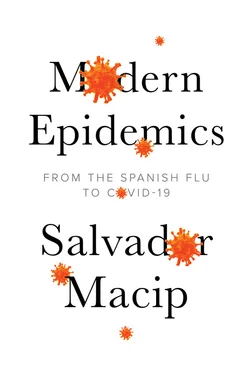But we also need to remember that studying viruses is complex and expensive, especially because of their size. In the words of Luis Martínez-Sobrido:
We virologists are like astronomers. Both need big, expensive equipment to magnify very small and distant objects. Viruses are so tiny you can’t see them with traditional microscopes. They require expensive, complex, electronic microscopes. Computer science is revolutionizing this field, but there’s also a big economic cost. The same thing goes for the reagents that are necessary for cultivating and studying viruses. Nevertheless, the main limitation isn’t economic resources but personnel. It seems that the adventurous, inquiring spirit has been disappearing lately, perhaps because our society values other qualities more than research or working to improve the quality of life. After all, the budget of a research laboratory is less than what many footballers are paid.
Viruses aren’t only harmful because of the infectious diseases they cause. It’s also been found that they play an important role in cancer. Some experts say that up to 20 per cent of cancers could have a viral cause, although at the moment only a few are known and the figure could be much higher in reality. For example, there’s a relationship between certain kinds of hepatitis and liver cancer, between the retroviral infection HTLV-1 and leukaemia, and between the human papillomavirus and cancers of the uterus (which is why a vaccine was produced to protect women against the virus and, hence, cancer). It’s also believed, as some studies suggest, that the onset of diabetes might be in some way related to previous viral infections. One theory ventures that certain viruses might force our defence systems to attack our own tissues, which would eventually destroy the pancreas cells that produce insulin.
Fungi: microscopic mushrooms
The third large group of microorganisms that cause major health problems are fungi. There are about 1.5 million different species, of which, once again, only a small part – 5 per cent – is known. Some 300 that are toxic for humans have been identified. In general, they are bigger and more complex organisms than bacteria or viruses. Most of them consist of sets of cells, but there are also some with just one cell. Many species of fungi are microscopic, but some are easily identifiable to the naked eye, for example mushrooms or those responsible for mould on food. Fungi also participate in processes of decomposition and fermentation and have been very important in the discovery of antibiotics, as I will explain below.
The fungi that cause diseases in humans are, in particular, of the genera Aspergillus, Candida and Cryptococcus . Fungus infections are unusual and are especially seen in immunocompromised people, for example those suffering from AIDS. In such cases, they can even cause death. Candida are the fourth most common cause of blood infections in hospitals, with a 40 per cent mortality rate. Infections spread by Aspergillus , which are less common, kill in 80 per cent of cases. Cryptococcus neoformans , which left untreated can cause death, accounts for about a million fatalities worldwide every year, some 60 per cent in sub-Saharan Africa. It usually enters through the lungs and spreads rapidly around the whole body.
Fungi are especially resistant to treatment. There are only a few kinds of effective drugs (called antifungals ) and some fungi have already developed resistance to them. A further problem when treating fungal infections is that it usually takes too long to diagnose them. It is necessary to wait until the fungi extracted from a patient grow in a special medium before they can be identified, a process that can take up to forty-eight hours, during which time the infection can worsen. New techniques are presently being studied with the aim of reducing this waiting time to a few hours.
1 1. This and the following quotes are from an interview by the author with Luis Martínez-Sobrido [translation: JW].
2The Story of a Never-Ending Struggle
It took us many centuries to discover that we were being killed by living beings we couldn’t even see. In fact, we’ve been at the mercy of microorganisms for most of our history because we didn’t have a good strategy for dealing with them. This is a struggle we were spectacularly losing until very recently. At least in developed countries, science has provided us with tools – which I will describe in the next chapter– that can end up holding many kinds of microbes in check. Furthermore, we now know the cause of almost all infectious diseases and how they are transmitted, which allows us to look for effective means of curbing them with social, health, hygienic and even urban planning interventions. In some extraordinary cases, we’ve achieved the total elimination of a microbe from the planet and it’s possible that we will soon be able to repeat this feat with others. Despite this situation, which invites some degree of optimism, we shouldn’t forget that, on numerous occasions throughout history, microbes have influenced our destiny as a species.
The invisible hand behind things
The fact is that microorganisms have played an extremely important role at crucial moments in the history of humanity. And vice versa. The fact that we’ve been evolving and constructing complex social networks has enabled infections to spread much more efficiently to reach every continent, which they might never have achieved without us. This parallel progress of humans and microbes began when our ancestors left their nomadic life and started living in settlements where they set about cultivating the land. As towns and cities grew bigger, more people lived in close proximity, sanitary conditions worsened and diseases spread more easily. Outside organisms, the chances of survival of microbes causing tuberculosis or leprosy, for example, are very slight, and they could therefore only start spreading contagion in any significant way when human beings started to live crammed together. Prior to this, it was difficult for these microbes to jump between small groups of people who lived in isolation from each other, which is why they never caused epidemics.
When they made the transition from hunters to farmers, humans also came to share their living space with domesticated animals. It is believed that this made it easier for many microbes to jump from one species to another. For example, diseases as widespread as smallpox, mumps, diphtheria, measles and whooping cough are caused by microorganisms that, in all likelihood, originally came from animals. In the coming chapters, we will see that this is also true for the more recent pandemics.
We have no record of any epidemic until the classical Greco-Roman period when there were three known major plagues. The plague of Athens (of 430 BCE, the oldest epidemic on record) broke out after the inhabitants of nearby towns fled to the city to seek protection from the Spartan advance. The terrible conditions of hygiene in overcrowded Athens allowed the epidemic, perhaps smallpox, to spread unchecked. A quarter of the population died of the plague, eventually giving victory to Sparta in that war, which is why it’s said that, in some sense, a microbe hastened the end of the golden age of Greek culture.
The second major epidemic of the period is that known as the Antonine plague, which hit the Roman Empire in 166 CE. It probably originated in Seleucia (about 30 kilometres southeast of modern Baghdad) and is also thought to have been smallpox. It marked the beginning of the decline of Rome, which was completed with the third great disaster, the Justinian plague, in Constantinople in 542 CE. Apparently caused by the bacterium Yersinia pestis , it lasted for a year, followed by two whole centuries of new outbreaks, and it is thought to have killed a total of 100 million people.
Читать дальше












